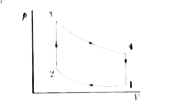SAMPLE PROBLEM 21.1 from RESNICK AND HALLIDAY PHYSICS (HINGLISH) THE FIRST LAW OF THERMODYNAMICS for Class 12
| Class 12 | PHYSICS |
| Chapter | THE FIRST LAW OF THERMODYNAMICS |
| RESNICK AND HALLIDAY PHYSICS (HINGLISH) | SAMPLE PROBLEM 21.1 |
| Medium | English |
| Academic Year | 2023-2024 |
Question 3
Let 1.00 Kg of liquid water at 100∘C converted to steam at 100∘C by boiling at standard atmospheric pressure ( which is 1.00 atm or 1.01×105 Pa ) in the arrangement of the volume of that water changes from an initial value of 1.00×103m3 as a liquid to 2.671⋅103m3 as steam
(a) How much work is done by the system during this process ?View SolutionQuestion 4
Let 1.00 Kg of liquid water at 100∘C converted to steam at 100∘C by boiling at standard atmospheric pressure ( which is 1.00 atm or 1.01×105 Pa ) volume of that water changes from an initial value of 1.00×103m3 as a liquid to 1.671m3 as steam
How much energy is transferred as heat during the process ? View SolutionQuestion 5
Let 1.00 Kg of liquid water at 100∘C converted to steam at 100∘C by boiling at standard atmospheric pressure ( which is 1.00 atm or 1.01×105 Pa ) in the arrangement of Fig 21-7 the volume of that water changes from an initial value of 1.00×103m3 as a liquid to 1.671m3 as steam
(c ) what is the change in the system internal energy during the process ?View SolutionQuestion 6
The P-V diagram in Fig 21-8 a represents a series of processes performed by an ideal gas , comprising a cylic process of operations . Fil in the table in Fig 21-8 b for this cycle using "+" to indicate an increase in the quantity listed "-" to indicate a decrease , and "0" to indicate no change .View SolutionQuestion 7
A bubble of 5.00 mol of helium is submerged at a certain depth in liquid water when the water ( and thus the helium ) undergoes a temperature increase ΔT of 20.0∘ C at constant pressure .As a result the bubble expands the helium is monoatomic and ideal
(a) How much energy is added to the helium as heat during the increase and expansion ?View SolutionQuestion 8
A bubble of 5.00 mol of helium is submerged at a certain depth in liquid water when the water ( and thus the helium ) undergoes a temperature increase ΔT of 20.0∘ C at constant pressure .As a result the bubble expands the helium is monoatomic and ideal
(b) what is the change ΔEint in the internal energy of the helium during the temperature increase ?View SolutionQuestion 9
A bubble of 5.00 mol of helium is submerged at a certain depth in liquid water when the water ( and thus the helium ) undergoes a temperature increase ΔT of 20.0∘ C at constant pressure .As a result the bubble expands the helium is monoatomic and ideal
How much work W is done by the helium as it expands against the pressure of the surrounding water during the temperature increase ?View SolutionQuestion 10
We transfer 1000 J as heat to a diatomic gas, allowing the gas to expand with the pressure held constant. The gas molecules each rotate around an internal axis but do not oscillate. How much of the 1000 J goes into the increase of the gas's internal energy? Of that amount, how much goes into ΔKtrans (the kinetic energy of the translational motion of the molecules) and AK (the kinetic energy of their rotational motion)?View SolutionQuestion 11
Initially an ideal diatomic gas has pressure pi=2.00×105 Pa and volume V=4.00×103m3. How much work w does it do, and what is the change ΔEint, in its internal energy if it expands adiabatically to volume Vf=8.00×10−6m3?Throughout the process, the molecules have rotation but not oscillation.View SolutionQuestion 17
The cycle of a petrol engine can be approximated by an Otto cycle (Fig. 21-20a). 1→ 2 and 3 → 4 are adiabatic compression and expansion, respectively, 2 →3 and 4→1 are constant-volume processes. Treat the working medium as an ideal gas with constant γ=Cp/Cv, Compute the efficiency of this cycle for g = 1.4 and compression ratio, r=Vi/Vf=10
 View Solution
View Solution

